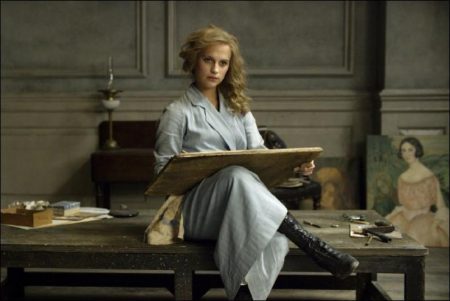Lili Elbe defied convention and pushed the boundaries of medical science to become the first transgendered woman. But at what cost?
Einar Wegener would kill himself in the spring. He had chosen a date – May 1, 1930 – after a year spent in torment. The cause of his suffering was quite simple: he was sure he was a woman, born into the wrong body. Or perhaps it was more complicated: sometimes Wegener, whose life is soon to be portrayed on film by the Oscar-winning British actor Eddie Redmayne in The Danish Girl, felt he was two people in the same body, each fighting for supremacy.
One was a Danish landscape painter, a steadfast man who, in his own words, “could withstand storms”. He was married to a woman whose strength and talent matched, or perhaps even surpassed, his own: Gerda Wegener, a successful Art Deco illustrator who produced portraits of fashionable women for magazines such as Vogue and La Vie Parisienne.
The other shared none of these qualities. Lili Elbe was, as she set down in letters and notes for an autobiography, a “thoughtless, flighty, very superficially-minded woman”, prone to fits of weeping and barely able to speak in front of powerful men. But despite her womanly defects, by February 1930 she was becoming too powerful for Wegener to resist. “I am finished,” he wrote at the time. “Lili has known this for a long time. That’s how matters stand. And consequently she rebels more vigorously every day.”
As it turned out, Wegener did not commit suicide on the appointed date. In February 1930 he was told of a doctor who might be able to help him – who did, in fact, perform a series of groundbreaking operations that allowed Einar to become Lili. But all the same, by September 1931, Elbe was dead, the victim of a misjudged surgery to transplant a womb into her body. (Ciclosporin, the drug that prevents the rejection of transplanted organs, was first used successfully in 1980, almost 50 years after Elbe’s death.)
In the year before her death, Elbe had divorced Gerda, given up painting, and was embarking tentatively on a relationship with a French art dealer. “It is not with my brain, not with my eyes, not with my hands that I want to be creative, but with my heart and with my blood,” she wrote. “The fervent longing in my woman’s life is to become the mother of a child.”
According to her own telling, Wegener’s transition into Elbe began by chance, when one of her wife’s life models failed to turn up. The couple’s mutual friend, an actress named Anna Larsen, suggested that the slight Einar might step in instead. At first she resisted, but eventually she gave in to Gerda’s pleas. “I cannot deny, strange as it may sound, that I enjoyed myself in this disguise. I liked the feel of soft women’s clothing,” she wrote. “I felt very much at home in them from the first moment.”
Extraordinary as it may seem, this accidental awakening unlocked such deep feelings that Wegener continued to dress as Lili – the name with which she was christened by Larsen – with the encouragement of Gerda, who used her as a model for her illustrations.
In 1912, the couple moved to Paris. There, Gerda accompanied Lili – or rather, “Einar’s sister” – to balls, and watched as she flirted with the unsuspecting officers they met there. In Elbe’s later telling, it was Gerda who became Lili’s greatest advocate, and for the next decade and a half they forged on with their unconventional marriage. There are suggestions that Gerda may herself have been gay; she certainly depicted women with women in her erotic drawings.
As the years passed, Wegener became increasingly unwell and depressed; she applied to doctors for help, but they responded with “headshakings” and “disdain”. Some diagnosed her as hysterical, others as gay. “I said to myself that as my case has never been known in the history of the medical art, it simply did not exist, it simply could not exist,” she wrote.
Wegener lived at the dawn of understanding of human sex and gender. In 1918, Magnus Hirschfeld, a German physician who also founded the world’s first gay rights organisation, opened the Institute for Sexual Research in Berlin. Having spent the previous 30 years documenting the experiences of homosexual men and women around the world, Hirschfeld’s intention was to turn sexology into a rigorous academic discipline. It was Hirschfeld who came up with the term “transsexualismus” for those who wanted to become, rather than simply appear to be, a different sex. (This is distinct from being transgendered, which does not necessarily imply a desire for physical transformation.)
At the turn of the century, doctors had conducted experiments which aimed to work out the biological basis for gender in animals. Professor Steinach of Vienna grafted ovaries into male rats castrated in infancy, and noted the growth of breasts and nipples. When they reached puberty, these “feminised” animals showed no interest in females in heat, and did not display male mating behaviour. The reverse, meanwhile, was true of female rats whose ovaries had been replaced with testicular grafts. Only decades later would scientists isolate, and ultimately synthesise, the sex hormones oestrogen and testosterone.
The procedures by which the then-47-year-old Wegener became Elbe are not precisely known, partly because the library and archive of the Institute for Sexual Research were destroyed by the Nazis in May 1933. In the biography Man into Woman, which incorporates many of Wegener/Elbe’s diary entries and letters, as well as conversations with the book’s “editor”, Niels Hoyer, details are elusive.
Certainly she underwent a series of operations at the Dresden clinic of Kurt Warnekros – a doctor described breathlessly in the book as a man of limitless masculine potency, Lili’s saviour and creator. These cost around 5000 kroner – around £12,000 in today’s money – which Wegener raised by selling off a number of paintings.
Aside from the fatal womb transplant, and the removal of Wegener’s testicles and penis, the ovaries of a young woman were also grafted into Wegener’s body. (Elbe suggests in her memoir that when she was operated on, an existing pair of shrunken ovaries was found in her body.)
Lili’s new surname, Elbe, was chosen for the river which flows through the city of her rebirth. After her initial operations, she seesawed between a feeling of astonished joy and moments of deep despair, when she feared she would never be accepted by the world at large. Many of Wegener’s male friends refused to see her, and she had the sense that she had “murdered” Einar. She abandoned painting, rejecting it as a relic of her former existence, and found herself increasingly detached from memories of Einar’s life.
On returning to Denmark, her older sister gave her a faltering welcome home. “Don’t be angry with me if I cannot yet properly call you by your name of Lili,” her sister said on their first meeting, “if I only seek for my brother when I look at you, in your eyes, at your mouth, at your hands, and at your forehead. For I loved his eyes and his forehead so much. I kissed his forehead so often.”
Her past life was disappearing into a fog. The Danish king agreed to annul her marriage to Gerda, and their divorce became official on October 6 1930. (Gerda later remarried an Italian officer who burned through her savings; she died penniless in 1940.) Lili was granted a passport in her new name. When she visited her sympathetic older brother, she told him that she could no longer remember where their parents were buried. Perhaps, she felt, she had no father and mother at all.
This sense of rootlessness came hand in hand with a passionate desire to create new life. In September 1931, after she underwent the womb transplant that would kill her, she sent a letter to her sister. “Now I know that death is near,” she wrote. “Last night I dreamt about Mother. She took me in her arms and called me Lili…and Father was also there…” On September 13 1931, Elbe died.
That summer, she had written a letter to another friend, reflecting on her life. It was weighted with the anticipation of death, but filled too with an aching sort of happiness. “That I, Lili, am vital and have a right to life I have proved by living for 14 months,” she wrote. “It may be said that 14 months is not much, but they seem to me like a whole and happy human life.”
Related Link: View the Full Production Notes for The Danish Girl
Views: 285





